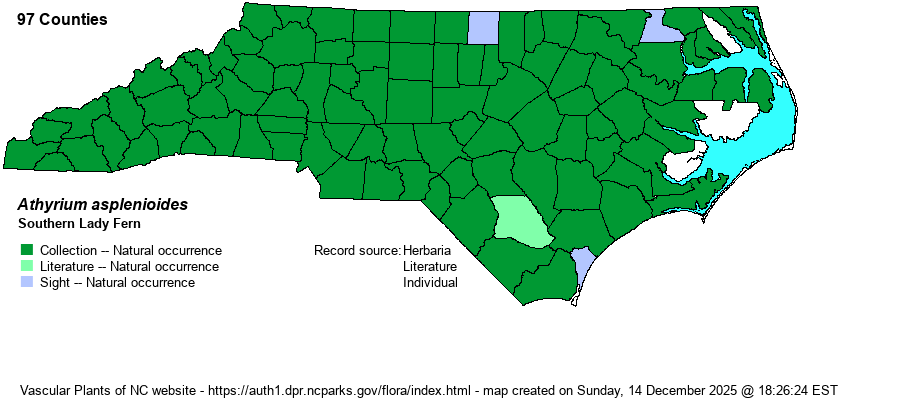| Author | (Michaux) A.A. Eaton | |
| Distribution | Throughout the state, certainly occurring in all 100 counties, but curiously absent from the barrier islands.
This is a very widespread species of the Southeastern states, ranging from MA and southeastern KS, south to central FL and eastern TX. | |
| Abundance | Common to often very common statewide, one of the most numerous and widespread ferns in the state. | |
| Habitat | This is a species of rich to moist forests, mainly under a hardwood canopy. It grows in bottomlands, rich to mesic slopes, and other similar places, usually in fertile soils, and less commonly in strongly acidic soils such as in blackwater floodplains. It may persist on open roadsides through former forest. |
| Phenology | Fruits from May to September. | |
| Identification | This is the most common of the lacy-cut ferns in deciduous forests in the state. The fronds grow in clumps, with the stipes green to brown, and about 8-10 inches long. The lanceolate to ovate blade is deeply dissected, bipinnate or bipinnate-pinnatifid, about 12-15 inches long and about 8 inches wide, tapered to the apex but somewhat squared-off at the base (i.e., the lowest pinnae equal to somewhat shorter than the ones above). There are about 20-30 pairs of pinnae, somewhat alternate along the rachis. The sori are oblong-linear, one beneath each lobe of a pinnule, diagonal to the midrib of the pinnule, such that there may be 15-25 or more sori under a single pinnule. Most other similar species, such as in the genus Dryopteris or Dennstaedtia, have rounded sori as opposed to oblong-linear ones. The species is especially easily confused with Hay-scented Fern (D. punctilobula), when sori are not present; that species tends to have a more yellow-green stipe and rachis, whereas Athyrium has a brownish stipe and especially rachis. For separation from the very-rare-in-NC A. angustum, see that species account. Beware of immature small plants, which may immitate other fern species. | |
| Taxonomic Comments | Many references in the past and present have this species lumped into the larger or more inclusive A. filix-femina, typically as var. or ssp. asplenioides.
| |
| Other Common Name(s) | Lady Fern -- generally in use for the combined A. asplenioides and A. angustum | |
| State Rank | S5 | |
| Global Rank | G5 | |
| State Status | | |
| US Status | | |
| USACE-agcp | FAC link |
| USACE-emp | FAC link |

